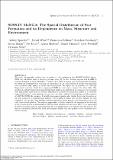Files in this item
SDSS-IV MaNGA : the spatial distribution of star formation and its dependence on mass, structure and environment
Item metadata
| dc.contributor.author | Spindler, Ashley | |
| dc.contributor.author | Wake, David | |
| dc.contributor.author | Belfiore, Francesco | |
| dc.contributor.author | Bershady, Matthew | |
| dc.contributor.author | Bundy, Kevin | |
| dc.contributor.author | Drory, Niv | |
| dc.contributor.author | Masters, Karen | |
| dc.contributor.author | Thomas, Daniel | |
| dc.contributor.author | Westfall, Kyle | |
| dc.contributor.author | Wild, Vivienne | |
| dc.date.accessioned | 2018-02-13T13:30:07Z | |
| dc.date.available | 2018-02-13T13:30:07Z | |
| dc.date.issued | 2018-05-01 | |
| dc.identifier | 251539208 | |
| dc.identifier | bfc12bff-5948-4b6d-bc3a-0d97cd965dc2 | |
| dc.identifier | 85042708691 | |
| dc.identifier | 000429276700046 | |
| dc.identifier.citation | Spindler , A , Wake , D , Belfiore , F , Bershady , M , Bundy , K , Drory , N , Masters , K , Thomas , D , Westfall , K & Wild , V 2018 , ' SDSS-IV MaNGA : the spatial distribution of star formation and its dependence on mass, structure and environment ' , Monthly Notices of the Royal Astronomical Society , vol. 476 , no. 1 , pp. 580-600 . https://doi.org/10.1093/mnras/sty247 | en |
| dc.identifier.issn | 0035-8711 | |
| dc.identifier.other | BibCode: 2017arXiv171005049S | |
| dc.identifier.uri | https://hdl.handle.net/10023/12711 | |
| dc.description | Funding: M.B. acknowledges funding from NSF/AST-1517006. VW acknowledges support of the European Research Council from the starting grant SEDmorph (P.I. V. Wild). | en |
| dc.description.abstract | We study the spatially resolved star formation of 1494 galaxies in the SDSSIV-MaNGA Survey. SFRs are calculated using a two-step process, using Hα in star forming regions and Dn4000 in regions identified as AGN/LI(N)ER or lineless. The roles of secular and environmental quenching processes are investigated by studying the dependence of the radial profiles of specific star formation rate on stellar mass, galaxy structure and environment. We report on the existence of ‘Centrally Suppressed’ galaxies, which have suppressed SSFR in their cores compared to their disks. The profiles of centrally suppressed and unsuppressed galaxies are distibuted in a bimodal way. Galaxies with high stellar mass and core velocity dispersion are found to be much more likely to be centrally suppressed than low mass galaxies, and we show that this is related to morphology and the presence of AGN/LI(N)ER like emission. Centrally suppressed galaxies also display lower star formation at all radii compared to unsuppressed galaxies. The profiles of central and satellite galaxies are also compared, and we find that satellite galaxies experience lower specific star formation rates at all radii than central galaxies. This uniform suppression could be a signal of the stripping of hot halo gas in the process known as strangulation. We find that satellites are not more likely to be suppressed in their cores than centrals, indicating that the core suppression is an entirely internal process. We find no correlation between the local environment density and the profiles of star formation rate surface density. | |
| dc.format.extent | 2054628 | |
| dc.language.iso | eng | |
| dc.relation.ispartof | Monthly Notices of the Royal Astronomical Society | en |
| dc.subject | Galaxies: star formation | en |
| dc.subject | Galaxies: evolution | en |
| dc.subject | Galaxies: structure | en |
| dc.subject | Galaxies: bulges | en |
| dc.subject | Galaxies: groups | en |
| dc.subject | Galaxies: clusters: general | en |
| dc.subject | QB Astronomy | en |
| dc.subject | QC Physics | en |
| dc.subject | 3rd-DAS | en |
| dc.subject.lcc | QB | en |
| dc.subject.lcc | QC | en |
| dc.title | SDSS-IV MaNGA : the spatial distribution of star formation and its dependence on mass, structure and environment | en |
| dc.type | Journal article | en |
| dc.contributor.sponsor | European Research Council | en |
| dc.contributor.institution | University of St Andrews. School of Physics and Astronomy | en |
| dc.identifier.doi | 10.1093/mnras/sty247 | |
| dc.description.status | Peer reviewed | en |
| dc.identifier.url | http://adsabs.harvard.edu/doi/10.1093/mnras/sty247 | en |
| dc.identifier.grantnumber | ERC-2012-StG-20111012 | en |
This item appears in the following Collection(s)
Items in the St Andrews Research Repository are protected by copyright, with all rights reserved, unless otherwise indicated.

